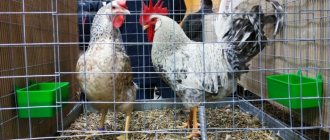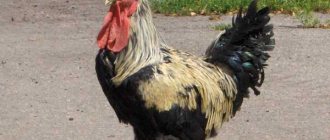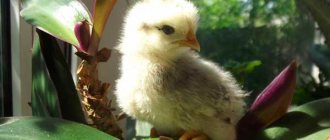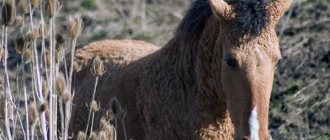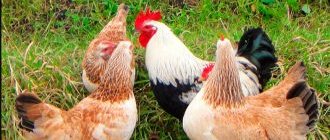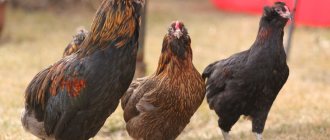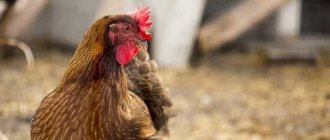Hisex chickens
If you approach the topic with due competence, then it is worth finding out that this friend of ornithologists and breeders is a cross – i.e.
a hybrid bred from the White Leghorn and New Hampshire bloodlines. However, the practical significance lies in the position of the “highsex”, which are known as the best layers at the moment. They are many times more productive than the base genetic line.
White Hisex
Despite their delicate size, the birds of this selection are capable of feats in terms of the size of the oval jewel, and an additional advantage is the permissible proportion of cholesterol in 65 grams of protein unit!
Moreover, the first clutch of pullets will not take long to arrive - the girls give results at the age of 140 days, and even within a year, one hen can delight others with a set of 280 testicles.
The breeder is required to control the balance of feed in terms of mineral composition and vitamin complex, as well as create acceptable climatic conditions to maintain such high productivity.
Brown variety
This is the same relative, but with a more massive body, which gives reasons to classify it as a meat-egg fellow tribesman. The masonry index with proper care reaches 300 pieces. with intense brownish color.
The relative strength of the shell is known to reduce the percentage of breakage during transportation. Brown Hisex is distinguished by a phlegmatic character, reduced tone, and therefore is not aggressive.
The factor of a calm attitude towards neighbors and a flexible, patient attitude towards the owners is suitable for cage breeding of this pet. Egg breeds of laying hens.
How to choose on the market: what parameters should you rely on when choosing?
You can buy day-old chicks and wait until they grow up to realize that there are more cockerels in the flock than hens. Or you can buy young animals, basing your selection on characteristic exterior features.
Signs of good egg production can be:
- Comb and its color;
- The volume of the abdominal cavity and its softness;
- The distance between the pubic bones (at least 3 fingers of an adult’s hand);
- If the bird is closer to the egg type, then the brow cranial arches are poorly developed and the front part of the head is characterized by weak hair.
When purchasing egg-bred chickens on the market, you should take a close look at the pigmentation of the beak. The more productive the laying hen, the faster it disappears.
Pushkin striped-motley
The breed was bred specifically for farming. Selection lasted from the mid-70s. to 2005 at the Experimental Farm of the Scientific Research Institute of Growing Animals in Pushkin. The official name of the breed is Pushkin Striped-Motley. There are two varieties of the breed - “Moscow” and “Petersburg”, they differ in the nuances of the interior and productivity.
Appearance. Beautiful exterior. The plumage is black and motley, the undercoat is white. The chickens seem to be covered in snow. The roosters are light with dark spots. The head is small, elongated. The beak is light, curved. Rose-shaped comb, large earrings. The tail stands vertically. The wings are long and slightly drooping.
Productivity. Egg production is 220 eggs per year. There are also 250-270 pieces. Egg weight – up to 58-60 g. Laying hens weigh 1.8-2.5 kg, roosters – 2.6-3 kg.
Other features. The carcasses have a beautiful presentation. The meat is delicious. They lay eggs from 5 months. They lay eggs for 3-4 years without reducing their reproductive rate.
Conditions of detention. Unpretentious and hardy, resistant to disease. They winter in unheated poultry houses. Roosters with rose-shaped combs tolerate frost better; leaf-shaped combs can be frostbitten.
Italian partridge
This Italian laying hen can also be called a brown or brown relative of the previous cross.
Short description:
- Yellow beak;
- Leaf-shaped scallop;
- Average sizes of head and body;
- The weight of a mature individual reaches 1.8 kg.
In the first year, the productivity of the mother stock yields a benefit of 180 eggs weighing 60 g, having a white shell.
The best egg-laying hens for home breeding
The list of chicken breeds that are known for the best egg production is updated year after year. When answering the question of which chicken breeds have the most delicious eggs, the most egg-producing breeds are also named.
Klusha record holder Brown Nick
Brownie laying hens and cockerels are distinguished by their external miniature size; they rarely exceed 2-2.5 kg in weight. However, they have many other advantages. Having begun to lay eggs at the age of 5 months, such a hen is capable of producing up to 400 eggs per year, and she lays eggs at the same rhythm all year round. In terms of productivity, no other can compare with them. Brown Nick chickens are very hardy and calm, including the cockerels.
Legendary Leghorn
It is generally accepted that chickens of this breed are always white. This was true, but now that buyers began to prefer eggs with brown shells, breeders began breeding birds with colored colors. And they succeeded. Chickens of this breed are very calm, they are used in industrial production, and farmers love them. During the year, the laying hen produces about 300 copies of its products, which is much more than others. Leghorns begin to lay eggs at 4 months.
Leghorn is one of the oldest breeds
The High Line is the breed that rushes the most
High-line chickens are widely popular in Western Europe and South America. But they are gradually becoming familiar in Russian spaces. Birds of the High Line breed are beautiful, calm, resistant to disease, and most importantly, chickens lay eggs often (more than 300 eggs per year).
Loman Brown - miracle layers
The hybrid breed Loman Brown is distinguished by its unusually early maturation - already at the 22nd week, the hens begin to lay eggs, rapidly picking up the pace. And by 30 weeks they reach their maximum level of egg production. During the year this figure is up to 300 pieces. The color of the eggs is even beige and brown, the shell is very strong, which allows for long-term transportation. These birds are unpretentious in keeping.
Kuchinsky jubilees are chosen for their delicious eggs
This breed has unusually beautiful, elegant roosters and hens of golden color with black edging. The eggs of Kuchin laying hens are distinguished by their large size and excellent taste. The birds quickly get used to the owner, the poultry house, and are calm and friendly. They are unpretentious to food and can feed themselves in walking conditions. After the second year, the birds' productivity decreases.
Kuchin laying hens and cockerels are very friendly
New Hampshires are curious and trusting.
These birds are distinguished by great curiosity and a friendly disposition. The cockerels take care of the hens, often they become completely tame. New Hampshire hens lay brown eggs, the first ones at the age of 3 months, with an average of 200 eggs per year.
Isa Brown the little girl
The hybrid was developed by Dutch breeders by crossing several breeds, including Leghorns. Isa Brown hens are valued not for their beauty, but for their high egg production - 320 eggs per year. There are often two yolks in an egg.
Important! Isa Brown chickens are distinguished by the fact that they eat little. They only need 110 g of feed per day. Chickens need regular walking; they are active and love to look for pasture on their own.
Chickens need regular walking; they are active and love to look for pasture on their own.
Russian White is the fastest ripening
These chickens were bred specifically for distribution in Russia. The birds are hardy and have good immunity. The main advantage is early maturity; per year, laying hens produce about 240 eggs of white or yellowish color, elongated in shape. The results practically do not decrease within 2-3 years.
Russian Crested – rich in eggs
This chicken feels good both in industrial workshops and on farm paddocks. Both in the heat and in the cold, these beauties with tufts delight their owners. They are distinguished by great mobility not only in summer, but also in winter, at the first opportunity they go out into the open air for a walk. Curius's character is friendly and sociable.
Italian partridge - decorative, and not only
The color of the chickens of this breed is multi-colored, with a golden tint. Young laying hens begin laying eggs at 5 months. The eggs are white, weighing up to 60 g. In the second year they reach maximum productivity - about 220 eggs. Then the results decrease, and the egg-laying hens need to be replaced.
Italian partridge hens and roosters will decorate any yard
Optimal conditions for keeping chickens
In order for chickens to lay eggs more, you need to properly organize their care. One of the most important aspects is the area where birds are kept and fed, namely:
- the poultry house needs regular ventilation and cleaning;
- the height of the chicken coop should be up to two meters;
- the optimal temperature in the warm season is up to + 28, in the cold season up to +8;
- Brooders should not be crowded. If a similar picture is observed, perhaps the chickens are cold or the area is overpopulated;
- for laying eggs, install rectangular wooden boxes with straw or hay;
- To prevent parasites from overpowering the birds, place several containers with sand and ash in the center of the brooder;
- if you plan to feed chickens with wet and dry food, there should be separate feeders for them, and drinkers with water should be slightly raised above the floor;
- Once a month, whitewash the walls, chicken roosts and floors with slaked lime;
- Feeding chickens should be balanced. Calcium, chalk and ground shell rock must be added to the feed.
Experience shows that it is better to breed and raise egg-laying chickens in a private backyard. These breeds and crosses are undemanding in care, feed costs are insignificant, and such birds will be pleased with their first eggs already in the fifth month.
And in conclusion, we note that a good egg production rate largely depends on properly organized care and choice of cross. Therefore, if you are planning to start raising birds, first research the best varieties, and then decide which birds will grace your yard.
Noble beauties of the Sussexes
Individuals of this breed are distinguished by their elegant appearance.
Chickens with a characteristic pattern on the neck and tail attract attention with their grace. There are many color options for individuals: Colombian, fawn, white, lavender, porcelain, brown, etc.
Light Columbia Sussex
The most popular in Europe and Russia is Colombian. Representatives of this species are white with a dark “necklace” on the neck. The ends of the flight and tail feathers are also painted black.
Sussexes in the poultry house - photo
The main characteristics of the breed are as follows:
- weight – 2.4-2.7 kg (females), 3-4 kg (males);
- egg weight – 56-58 g;
- beginning of oviposition – 5th month of life;
- productivity – 170-190 pcs.
The Sussex breed is very precocious: with proper care, young animals gain slaughter weight at 100-120 days of life. The breed's egg production depends on the time of year: in winter, productivity drops significantly, so on large farms chickens are often slaughtered with the onset of cold weather.
Sussex chickens
Andalusian chicken
Chickens with an unusual color find themselves only on private farmsteads, since the breed is not used on an industrial scale due to its low (industrialists’ opinion) egg production.
The young begin to lay eggs at six months of age, with eggs weighing 55-62 grams. Egg productivity is 185 eggs per year. Andalusian chickens can also be used for meat; the weight of chickens reaches an average of 2.7 kg. The instinct for incubation is underdeveloped, but it is possible to obtain a brood with high survival rate. However, to get numerous offspring, it is better to use an incubator.
Araucana
Chickens with blue pigment on the surface of the shell are known to Europeans from descriptions that are just under half a millennium old. The bird has long been considered an exotic and mysterious stranger to the whole world, except the shores of South America.
In 1920, in The Hague, Araucana was presented to the world community as part of a nomination in the World Scientific Poultry Association. The characteristics of the overseas tribe quickly won the hearts of European poultry farmers.
Further fruitful work of breeders delving into the unusual genetic findings of birds has led to the fact that birds can now be bred in several current standards.
Character
Experts characterize a chick's temperament with very contradictory definitions: from peaceful to aggressive. Girls for the most part are calm, but their suitors are irreconcilable with any stranger, especially during the period of mating battles - in the spring, and may well allow themselves to bully even the owner if they are driven by suspicion of a threat to the herd.
Productivity
One of the key reasons why poultry keepers get the beautiful Araucan is the peculiar tinting of the shell - blue or greenish. With a competent approach to maintenance, the mother stock is capable of laying 160-180 specimens in twelve months.
The period of sexual maturity begins at six months of age, however, reviews also describe “late-ripening” cases when individuals begin to lay eggs only towards the end of the first year of life.
Income from rare breeds
In addition to stable profits, there is another advantage to this. Chicken breeding as a business using rare breeds of laying hens. I breed Araucans, because a hen and a rooster (a married couple) costs 10-12 thousand rubles for sale, it’s very profitable! Year-round incubation of blue eggs allows us to more than cover all the costs of maintaining other chickens and improving the chicken coop.
In the photo there is a family of a tailless breed: a bearded rooster Sebastian and a gray laying hen Josephine - our nurses.
Some poultry farmers rely on selling unusual chickens. This can be quite a profitable business if structured correctly. Today poultry farmers dream of exotic, decorative, rare hens. Such birds are not cheap, so breeding them will quickly pay for itself.
But there are some nuances
To earn income from unusual breeds, it is important to create ideal conditions for the hens. It's no secret that rare and unusual quons require more attention - they need special care, warmth, and high-quality food
Moreover, to start such a business, a considerable amount of investment will be required - both for the purchase of livestock and for home improvement.
https://youtube.com/watch?v=kyZ_TMKNON8
Fourth place - Leghorn
The Leghorn chickens were a little behind the leaders. What are the easiest to maintain and care for in a poultry house? It's them! Until relatively recently, Leghorn laying hens were considered the best among all chicken breeds in terms of egg production. Today, breeds have been bred that are somewhat ahead of the Leghorn in this indicator, but in terms of unpretentiousness, acclimatization to conditions and ease of keeping, these chickens are still the best.
Adult Leghorn chickens weigh 1.5-2 kg, roosters - up to 2.5 kg. Birds early - at 4.5-5 months - enter productive age and lay intensively throughout the first season, laying from 220 to 300 eggs weighing 55-58 g. The shells of the eggs are predominantly white. Chickens of this breed hold the absolute record - 365 eggs laid per year!
For all their advantages, these birds have one, but very significant drawback - they have a poorly developed instinct for hatching chicks. When the first two or three chicks are born, the Leghorn mother often abandons the rest of the eggs in the clutch, so it is better to breed the chicks in an incubator. After the first season, the egg production of Leghorns decreases noticeably, although not as catastrophically as that of Browns. But still, after the birds reach this age, it is better to rotate the herd, replacing old laying hens with young ones.
Domestic representatives
The most egg-laying breed of chicken after Leghorns is the Russian White. This species is a hybrid of the previous representative and outbred chickens. In terms of egg production, they practically do not lag behind Leghorns - 240 eggs per year on average, and sometimes even 300. In weight, they practically do not differ from their ancestors. The scallop is large, leaf-shaped.
Unlike its ancestors, this breed is stress-resistant and non-aggressive. The main goal of breeding work was to increase production qualities and improve immunity, which was completely successful. They are simply not replaceable in the household. This breed of chicken is especially suitable for beginners in poultry farming, because raising it does not require any specific skills.
Already from the name itself it is clear that representatives of the species are snow-white. Their main difference is that the color of the plumage is even, without yellowness. Subsequently, as a result of selection, the snow white subspecies was bred. In this subspecies, even in chickens on the first day, part of the down is white, not yellow.
conclusions
In homestead livestock farming, chickens of egg breeds are often raised. Among the most productive are Leghorn, Russian White, Highsex, Loman Brown, Kuchinskaya Jubilee. Every 2-3 years, due to a decrease in productivity, chickens are culled, and the poultry farmer buys replacement young stock. To select egg-laying chickens for further use, you need to pay attention (especially to beginners) to the following exterior signs of high productivity:
- The correct distance between the pubic bones should be at least 3 fingers of an adult’s hand.
- Volumetric and soft belly.
- Brightly colored and elastic comb and earrings.
- Yellow pigmentation of legs, iris, beak. In the fall, it is paler in highly productive chickens.
- Shedding. Good layers molt in mid-autumn.
- Plumage. In a healthy and highly productive bird, it is shiny and tightly adjacent to each other.
You can read about why chickens go bald here.
Breeds
Today, there are a huge variety of egg breeds, among which there are both natural species and artificially bred varieties obtained as a result of breeding work. Below is a rating of the best egg-laying breeds, which are profitable to keep not only in large poultry complexes, but also in households.
Leghorn
This breed of chicken is perhaps the most popular and is actively used for industrial poultry farming. The birthplace of the breed is Italy, where, in the vicinity of the city of Livorno, American breeders conducted experiments on crossing Italian chickens with laying hens from Japan and Spain. The result of painstaking work was the creation of a new highly productive breed of chickens capable of producing up to 300 eggs per year. Leghorns reach sexual maturity very early, and they are able to lay their first egg at the age of 4 months. Both hens and roosters have a light build, a large leaf-shaped comb and a long, curved neck. The plumage is most often white, but sometimes blue, fawn and speckled individuals are found. The cost of hatching eggs is 30-40 rubles, one-month-old chickens will cost 250 rubles per head, and 5-month-old chicks will cost about 500 rubles.
Russian white
This domestic breed is perfectly adapted to the local climate and Russian feed, and does not cause any difficulties when growing. Many experts recommend keeping Russian white chickens as your first stock. The breed is the result of selection, which was carried out with the participation of white Leghorns and local breeds. As a result, we managed to obtain a fairly large egg-laying bird, capable of laying eggs from the age of 5 months and producing up to 260 eggs per year. The main advantage of the breed is its stable productivity, which does not decrease due to extreme heat or lack of feed, and its absolute unpretentiousness in maintenance. In addition, chickens have a very peaceful character and get along well with other residents of the poultry yard. The cost of chickens ranges from 30 to 100 rubles and depends on the value of the parent stock.
Loman Brown
This cross is considered the most popular in Europe. It is characterized by simple content and high productivity. The breed was bred in Germany, and birds of the Rhode Island and Plymouth rock breeds were taken as parent individuals. Egg production begins at the age of 135 days and reaches its peak at 180 days. During the first year and a half, a laying hen is capable of laying up to 330 eggs per year, after which productivity decreases slightly and remains within the range of 250-280 eggs. Among the advantages of the breed, one can note the low consumption of feed, and among the disadvantages is the impossibility of producing offspring naturally. However, this problem is common to most hybrids, which does not make them any less popular. The cost of a hatching egg from a breeding station is 40 rubles, and a 2-month-old chicken will cost 150-200 rubles.
Isa Brown
This hybrid cross is characterized by high egg production and was obtained from crossing Leghorns and Rhode Islands. The homeland of the species is Holland, from where it very quickly spread first throughout Europe and then throughout the world. During the first year of life, the productivity is more than 370 eggs, which allows you to get a fresh egg literally every day. However, by the age of one and a half years, egg production drops somewhat, but for a long time it remains at the level of 200-250 pieces. According to most experts, this cross has a close relationship between nutritional balance and performance, which can be attributed to both pros and cons. The cost of hatching eggs ranges from 40 rubles, and for an adult 5-month-old egg you will have to pay at least 500.
Dominant
This cross is economically profitable and belongs to the universal breeds. The egg production of an adult at the peak of productivity is at least 300 eggs per year. The birds are distinguished by their large build and beautiful multi-colored colors. Based on the color of feathers, there are 12 varieties, of which the most popular in our country are black and blue, as well as Sussex. The weight of an adult chicken reaches 2.5 kg, a rooster - 2.8 kg. The cost of a hatching egg is 40 rubles, and for a 4-month-old pullet you will have to pay about 550 rubles.
The best meat and egg breeds of chickens
We recommend reading our other articles
- Onion variety Slizun
- Varieties of cucumbers for greenhouses
- Adjika from green tomatoes
- The benefits and harms of corn
Meat and egg breeds of chickens differ in that, in addition to a large number of eggs, they also have tasty meat, which is equivalent to the meat of broiler breeds.
The best meat and egg breeds of chickens
- Kuchinskaya Jubilee is a breed of meat and egg-laying chicken, bred by Russian breeders. The bird has a strong build, dense feathers adjacent to the body. The comb is leafy, the beak is elongated, the eyes are yellow-red. The plumage is most often brown in females, while roosters have more elegant, golden feathers. The weight of the male is 4 kg, the female is 3 kg. Poultry is slaughtered for meat at 10 weeks. The meat tastes better than broilers. Egg production of females is 200 pcs./year. The weight of the egg is 60 g. Among the disadvantages, there is a tendency to obesity.
- Rhode Island is one of the best meat and egg breeds. The birds are dark red in color with black tails. They have a dense physique and excellent health. Chickens begin to lay eggs at 6.5 months. During the year, a laying hen produces about 180 eggs weighing 60 g, brown in color. The survival rate of young animals is 98%. The average weight of an adult chicken is 3 kg, males are 1-1.5 kg more. The main drawback is the lack of maternal instinct.
Important!
For all its advantages, meat from egg breeds also has many disadvantages. They require regular walking, take a long time to grow and can be aggressive.
Foxy Chick is a breed of egg-laying chicken, characterized by high productivity at low feed costs. This is a cross species, so young animals have to be purchased, but the expenses pay for themselves. Color – bright red with different shades. The bird doesn't eat much. The weight of an adult female is 4 kg, a male is up to 7 kg. Chickens produce approximately 300 eggs per year, the shells are brown.
It is also worth including such breeds as New Hampshire, Orpington, Adler silver, Faverol, and Moscow black.
Ukrainian earflaps
Unfortunately, there is not much reliable information about the sources of origin of this unique breed.
Short description:
- Large head;
- Low, pink legs;
- Delicate body size;
- Large leaf-shaped comb;
- Lobes covered with fine feathers;
- Beautiful tail with rounded edges of feathers;
- The average weight of an adult is in the range of 1.8-2.3 kg;
- The coloring is mostly black, but brown-red and gray are also available.
Ukrainian long-eared females reach gender maturity already at six months. One year of labor-standard work of a feathered worker can be up to 170 eggs, but there are cases of record productivity - 214 units. The standard weight of each copy of the usual protein product is approximately 50 g; the shell has a creamy pigment.
What is unusual for the qualification of laying chicks under consideration, is quite inherent in the Ukrainian earflaps - the possession of maternal instinct. The breed is ideal within the interests of poultry farmers who, in addition to a significant number of eggs, value the high perseverance of the hens.
Mothers are excellent at hatching their future offspring, and their beautiful chicks fledge early enough. Due to good cover, they can withstand harsh winters.
Malaysian Serama
A recently developed breed created by crossing Malaysian wild chickens and Japanese dwarf chickens. The birds are comparable in size to pigeons.
Peculiarities:
- minimum weight - from 250 to 300 g;
- maximum body weight - 600 g;
- average egg production - 20 eggs annually;
- cellular maintenance in room conditions is suitable;
- The birds are very thermophilic and stop laying at temperatures below 25°C.
In addition to its miniature dimensions, its distinctive feature is the high stance of the body, the swan neck and the tail raised at a right angle. Pedigree is determined by the size of the cervical curve.
Seramas from Malaysia are the smallest chicken species in the world.
Milfer
When creating this breed, breeders were guided solely by aesthetic considerations. Birds are bred for their catchy, beautiful plumage. Due to their compact shape, they can be kept at home.
Peculiarities:
- the predominant plumage colors are tricolor, black and white, speckled blue and porcelain;
- number of eggs per year - from 100 to 140 pieces;
- egg weight - from 30 to 35 g;
- male weight - 800, chicken - from 600 to 650 g;
- Laying hens have excellent maternal instincts;
- chicks have a strong immune system;
- survival rate of young animals is from 96 to 98%.
Milfers have the most beautiful exterior among the dwarf varieties
The temperament of these chickens is far from peaceful. At the slightest hint of threat, they become aggressive. If you don’t put pressure on them, they behave calmly. Roosters are known throughout the world for their caring behavior towards their hens. They act patronizingly. When they see food, females are invited to the feeder. They eat themselves last.
Bantams
Originally from Southeast Asia. Despite the fact that there are also full-size ones, it is the mini versions that are in favor among poultry farmers.
Peculiarities:
- body weight of a rooster - up to 1, chicken - up to 650 g;
- average egg production - from 45 to 70 eggs annually;
- females are excellent brood hens.
Bantams are considered the first decorative breed in the world
A large number of variations of these birds are known, but the purebred bantam is widely represented, demonstrating productivity indicators of up to 130 eggs per year.
Representatives of this breed require special care in terms of hygiene. If the lush plumage on the legs and tail is not cleaned in a timely manner, they will lose their attractiveness.
Shabo
In everyday life, these birds are called Japanese bantams. Only a few poultry farmers classify them as a separate species. Due to the short legs, the body looks squat. It seems that the birds are crawling and not moving with their paws.
Peculiarities:
- weight of males - 600, chickens - 500 g;
- average egg production - from 80 to 150 pieces per year;
- egg weight - 30 g;
- daily feed consumption - 60 g.
Bred in the 17th century. Japanese breed Shabo
Birds have a calm character and lead a sedentary lifestyle. They prefer to stay in a flock, even going for food in organized rows.
Tips for choosing layers
How to choose the right breed of laying hens for your yard? It is quite difficult to answer this question. After all, it is necessary to take into account not only the advantages of breeds and crosses, but also their disadvantages.
In addition, the available conditions of detention are taken into account. Therefore, in this matter, we can recommend several rules, adhering to which a novice poultry farmer will be able to choose the appropriate option:
- If you plan to breed at home in the future, give preference to chicken breeds. After all, most crosses do not have the brooding instinct. Well, in the case when breeding is not planned, you can purchase chickens annually;
- What conditions exist at your site? If you plan to keep birds in cages, give preference to varieties that are unpretentious to living conditions. And remember, some hybrids are not designed for these conditions;
- When choosing a breed, the climatic zone of the poultry farmer’s residence is taken into account. The fact is that some breeds and crosses cannot tolerate extremely low temperatures. And if the chicken coop is not heated, there is a possibility that the entire flock will die.
And lastly, always be guided by the rule when choosing chickens, what you expect from the bird, egg production records or delicious poultry meat. And remember, even the biggest records don’t last.
At what age do laying hens start laying eggs?
Laying hens begin laying eggs during puberty. It depends on:
- Bird breeds. From young individuals of egg breeds (Hisex White, Loman Brown) you can get the first eggs after 4.5 months, meat-egg breeds - after six months, meat - after 8 months.
- Conditions of detention. It is necessary to provide more free space in the chicken coop (the optimal housing area is 4-5 birds / m2) and daily walking. The duration of daylight should be at least 13 hours.
- Complete feeding. The diet should contain greens, vegetables and mineral supplements. This will ensure that eggs are laid without delay.
Important! The egg formation process lasts 22-25 hours with proper care. The presence of a rooster (in a ratio of 1:10) is only necessary for hatching chickens from eggs. Helpful advice! Every autumn it is necessary to cull the herd so that in winter, during periods of low productivity, you do not spend extra money on feeding unpromising individuals.
Helpful advice! Every autumn it is necessary to cull the herd so that in winter, during the period of low productivity, you do not spend extra money on feeding unpromising individuals.
Laying hen performance
Many people are interested in the question, how many eggs can a chicken lay per day? One hen, if well maintained, produces one egg daily. In winter, fertility decreases. Some individuals lay eggs every other day, others a couple of times a week. This is influenced by the natural biorhythms of the bird.
The first year in the life of a laying hen is the most productive; already in the second year of keeping, egg production decreases by 15-20%, subsequently even more. In this regard, chickens are kept in households for no more than 3 years (in poultry farms - 1 year).
The idea of raising laying hens is characterized by high productivity and liquidity. After all, you can sell not only eggs, but also meat and fluff. The main advantages of the business idea: production of always in demand products with high demand, minimal investment to start a business, high potential for rapid development from a household to an entire farm.
Content Features
To achieve the best performance, you must strictly adhere to the bird care recommendations. The key to success is proper feeding and living conditions.
Accommodation
For egg-laying birds, the following indicators are extremely important:
- illumination at which the length of daylight hours will be at least 12 hours;
- temperature not lower than +6°C.
Important! Egg production at temperatures above +30
°
C drops by 30%, and when the temperature drops below +5
°
C
-
by 15%.
To maintain the required level of illumination, additional lamps are used. For free walking, it is necessary to provide the birds with an aviary with a protective fence, drinking bowls and shelter from the sun.
Feeding
Violation of the diet and composition of the diet leads not only to a quantitative, but also to a qualitative decrease in egg production.
For laying hens the following conditions are required:
- feeding on a schedule;
- increasing the diet in winter and during the molting period;
- improved mineral composition of the feed, especially calcium and phosphorus;
- access to fresh greens; in winter you can give dried grass.
Breeding
During the evolution of egg-laying breeds, the motherhood gene was hopelessly lost for many of them. It can be very difficult to place an active laying hen, so breeders use a “surrogate mother” or an incubator. In the first case, the eggs are placed under a more responsible hen and the offspring are awaited. When incubating breeding, it is recommended to choose incubators with an automatic egg turning mode and a thermostat. A good model for beginners would be the Layer BI-1, which can hold from 36 to 104 eggs, depending on the modification.
The device is equipped with a transparent viewing window located on the top panel, which allows you to monitor the condition of the eggs without opening the lid. In addition, the incubator is equipped with temperature and humidity sensors, operates on a 220 V mains voltage, and in the event of a lack of electricity can run on a battery. The operating temperature is 33-34 degrees, and chicks hatch on day 21.
The hatched chicks are left in an incubator or transferred to a special nursery to dry, after which they are transplanted into a box or box with a newspaper-lined bottom. The air temperature during the first two days should be maintained within 32-35 degrees, on the third day - 28-29 degrees, after which it is gradually reduced to 24 degrees.
Determining the egg production of laying hens
Second. A good chicken is selected based on daily productivity monitoring over a period of 7 days. In the morning, laying hens are inspected for the presence of eggs. The bird is fixed at the base of the wing, and lightly pressed on the cloaca to determine whether there is an egg or not. Good layers have it every day. In hens with poor performance, the gap between egg production may be several days.
Third. Appearance can tell a lot about productivity; first of all, the comb with earrings can be inspected. They should be large, soft to the touch and red in color. Chickens with low egg production have small, pale and wrinkled combs.
Fourth. Condition of the cloaca. Laying hens are distinguished by a large, moist, elongated cloaca. A chicken that does not lay eggs has a small cloaca, and it is also dry and compressed.
Short description
The egg-laying type of chickens is different from others. They have several main features that are typical for all representatives of this trend. Let's look at the main characteristics that distinguish good layers.
- First of all, it should be noted that almost all feathered beauties of the egg direction are characterized by a very fast rate of maturation. Most varieties can begin their working career as early as four months of age.
- Another feature is its low weight and compact frame. Birds of this variety do not have curvaceous shapes and can easily take off.
- Almost all of them have lush, thick plumage, which protects them from hypothermia. Some may pride themselves on being decorative.
- Klushi are more active than representatives of the meat or universal varieties.
